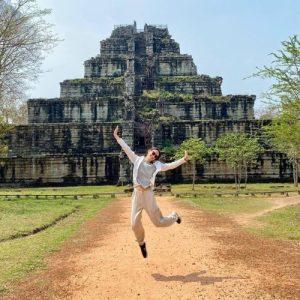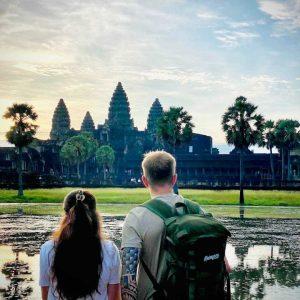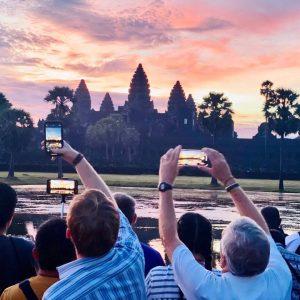Unearth the Mysteries of Ta Prohm Temple – A Guide to Angkor’s Iconic Jungle Temple
July 25, 2023
Table of Contents
Unearth the Mysteries of Ta Prohm Temple – A Guide to Angkor’s Iconic Jungle Temple
Ta Prohm Temple: Unearthing the Ultimate Adventure in Style
Stepping Back in Time: The Historical Significance of Ta Prohm
Nestled deep within the jungles of Angkor lies a temple lost to time, where ancient stones are slowly being reclaimed by the roots and vines of the encroaching jungle. This is Ta Prohm, a 12th-century temple built during the reign of King Jayavarman VII that stands as an awe-inspiring testament to the mighty Khmer Empire that once ruled this region.
As our guide leads us across the moss-covered causeway toward the crumbling ruins, it’s easy to feel as though we’ve stepped straight into an Indiana Jones movie. But the history of this site goes back centuries before Hollywood discovered it. Ta Prohm was originally constructed as a Buddhist monastery and university dedicated to the king’s mother. At its height, it housed over 12,500 people within its sprawling temple campus.
After the fall of the Khmer Empire in the 15th century, Ta Prohm was abandoned and left largely untouched for hundreds of years. When French explorers rediscovered the temple in the 19th century, they found its corridors and courtyards entwined with the roots of knotted fig and silk-cotton trees. It was like unearthing a forgotten treasure.
Today, Ta Prohm remains one of the most picturesque and atmospheric ruins at Angkor, offering a tantalizing glimpse into the glorious past of the Khmer civilization. As we explore its crumbling halls lined with intricate carvings of apsaras and meditating Buddhas, it’s as if we’ve slipped through a crack in time. The echoes of chanting monks and temple bells seem to reverberate just out of earshot.
Key Takeaways:
- Built in the late 12th century as a Buddhist temple and university
- Left in a largely unrestored, crumbling state unlike most Angkor temples
- Massive silk-cotton and strangler fig tree roots snake over the sandstone ruins
- Labyrinthine layout with winding corridors and hidden courtyards to explore
- Appeared in the 2001 film Tomb Raider starring Angelina Jolie as Lara Croft
- Come early morning or late afternoon for the best lighting and smallest crowds
- Wear breathable clothing, sturdy shoes, hat, and bring plenty of water
- Follow marked paths and refrain from climbing on fragile structures
- Keep an eye out for photogenic spots with symmetry, leading lines, and framing
Navigating the Ruins: A Practical Guide to Exploring Ta Prohm
With its photogenic atmosphere and iconic tree roots spilling over crumbling sandstone, it’s no wonder Ta Prohm is one of the most popular temples within the Angkor Archaeological Park. But navigating the sprawling complex can be a bit daunting for first-time visitors. Here are some tips to make the most of your Ta Prohm experience:
Get there early. Ta Prohm opens at 7:30am, so arrive just before then to beat the crowds. The soft morning light filtering through the jungle canopy enhances the temple’s mystical vibe.
Follow the designated circuit. There’s a set walking route marked by colored dots on the ground. This helps control crowd flow and prevents getting lost. It takes 1-2 hours to complete.
Watch your step. Uneven and crumbling floors make for tricky terrain. Tread carefully over jutting tree roots and pay attention to avoid loose stones or holes. Sturdy shoes are a must.
Respect the ruins. Refrain from climbing over fragile structures or removing any artifacts. This ensures Ta Prohm’s preservation for future generations.
Bring water & snacks. It gets hot and humid, traipsing through the jungle ruins. Hydration and fuel will keep you energized to enjoy the full experience.
Get a guide. Guides like those from Siem Reap Shuttle’s private Angkor temple tours provide valuable history and context to illuminate your exploration of Ta Prohm’s intricate carvings and history.
With some preparation and care, a visit to the atmospheric jungle temple of Ta Prohm is sure to be the adventure of a lifetime. Keep these tips in mind for an unforgettable experience.
Explore Angkor with Bayon Temple and the world-famous Ta Prohm (Tomb Raider) Temple
The Ta Prohm Experience: From Dawn to Dusk
The crumbling beauty of Ta Prohm enchants visitors any time of day, but watching the temple transform from dawn to dusk offers an extra magical atmosphere. Here’s what to expect during the different times of day:
Sunrise – Arrive before dawn to watch the first rays of sunshine filter through the canopy and cast a golden glow over the weathered stones. The slanting light creates striking beams and shadows for moody photos. You’ll beat the crowds and enjoy a peaceful, contemplative ambiance.
Morning – Explore the iconic tree roots and winding corridors while most groups are at Angkor Wat for sunrise. The cool morning temps make wandering through the maze-like ruins pleasant. Look closely to spot intricately carved apsaras and Buddhist imagery on walls and pillars.
Midday – After returning from Siem Reap for lunch, head back to Ta Prohm in the afternoon when crowds thin out again. The jungle seems to come alive with birdsong and insects buzzing through the sultry air.
Sunset – As the copper-colored sun dips toward the horizon, the sprawling temple makes for an evocative sunset spot. Linger on the outer gallery to admire the golden light illuminating Ta Prohm’s moss-laden towers one last time for the day.
No matter when you go, Ta Prohm’s crumbling beauty and atmospheric jungle surroundings will leave you awestruck. But experiencing the temple at different times adds new dimensions to appreciating this ancient wonder.
Comparing Ta Prohm Temple Features and Visitor Benefits:
| Feature | Benefit for Visitors |
|---|---|
| Crumbling, unrestored state | Evocative, exotic atmosphere unlike any other temple |
| Lush jungle surroundings | Feels like you’re discovering a long lost treasure |
| Iconic silk-cotton and strangler fig trees | Perfectly picturesque photo backdrop |
| Intricate Apsara carvings | Glimpse into incredible Khmer stonecraft |
| Winding corridors and hidden rooms | Sense of adventure exploring the maze-like interior |
| Appeared in Tomb Raider | Live your Lara Croft fantasies |
| Sheer size and scope | Get lost wandering smaller shrines away from crowds |
| Mystical aura | Opportunity to contemplate nature and human legacy |
Beyond the Silver Screen: Ta Prohm’s Role in Tomb Raider
Long before Angelina Jolie swung through the temple ruins as Lara Croft in the 2001 film Tomb Raider, Ta Prohm captured the imaginations of those who uncovered its mystical beauty. But there’s no denying the blockbuster spotlight increased this temple’s fame worldwide.
As our guide leads us through recognizable spots from the movie, it’s fun to picture the action sequences filmed here. We traverse the narrow passageway where Lara discovers the temple’s buried secret. Vines and knotted roots seem to come alive, just as they did to ensnare Lara. Up on the second level, we gain the vantage point where she glimpsed the temple’s treasure and plotted her daredevil maneuver to retrieve it.
But beyond Hollywood’s take, our visit here holds much more meaning. Ta Prohm gives us the chance to contemplate the rise and fall of empires, marvel at the ingenuity of Khmer engineering, and reflect on the relentless power of nature to both destroy and renew. This ancient place tells a story much greater than that of a fictional adventurer.
Yet seeing Ta Prohm’s iconic spots immortalized on the big screen still adds a touch more magic to wandering this lost temple. It’s fun to let your inner Indiana Jones come out amidst the photogenic ruins.
The Art of Ta Prohm: A Closer Look at the Temple’s Iconic Carvings
Though the giant silk-cotton and kapok tree roots snaking over the ruins grab most of the attention at Ta Prohm, taking time to appreciate the ornate bas reliefs and carvings here is well worth it. These intricate artistic details offer insight into the temple’s original purpose and the flourishing culture of 12th-century Khmers under Jayavarman VII.
Spaced along the outer gallery, our guide points out stunning carvings depicting scenes from Buddhist and Hindu mythology. Figures from the Reamker, Cambodia’s adaptation of the Ramayana, act out scenes of combat and conquest. Spires of grasping hands, symbolic of the grasping of Buddhist knowledge, reach out from pillars.
Though worn by time and the elements, many carvings still clearly depict the apsaras, or celestial dancing females, for which Angkor is renowned. Their elaborate headdresses, jewelry, and swaying fabrics exquisitely embody the Angkorian ideal of feminine beauty. No matter their condition, each delicate apsara carved into the ancient laterite and sandstone gives us a glimpse into the rich artistic heritage of the Khmer empire.
Ta Prohm’s ornate carvings may not be as immediately eye-catching as the photogenic tangle of trees, but they represent true masterworks of Cambodian stonecraft. Taking time to appreciate these temple carvings creates a deeper connection with Cambodia’s cultural legacy.
Surviving Ta Prohm: Essential Tips for the Modern Adventurer
Don’t let Ta Prohm’s crumbling jungle ruins intimidate you. With some preparation and common sense, both novice and seasoned travelers can safely navigate this temple maze and embrace their inner Lara Croft. Here are some essential survival tips for tackling Ta Prohm’s trails:
- Wear light, breathable clothing. Opt for moisture-wicking fabrics to stay cool in the sticky heat.
- Bring mosquito spray. The jungle environment means plenty of bugs buzzing about.
- Pack twice as much water as you think you’ll need. Hydration is key in the tropical climate.
- Wear sturdy, closed-toe shoes with good traction. Sandals or flip flops are asking for trouble on the uneven terrain.
- Watch your footing. Loose stones and unexpected dips are common. Take your time and tread carefully.
- Keep an eye out overhead. Massive trees and precariously balanced stones require caution.
- Ask for help navigating. Guides like those from Siem Reap Shuttle’s Angkor Wat sunrise tours can ensure you don’t get lost.
- Don’t climb the ruins. As tempting as it may look, clambering over fragile structures can cause irreparable damage.
- Have realistic expectations. Instagram perfection takes effort. Focus on simply soaking in the atmosphere.
Take on Ta Prohm’s trails with this practical advice, and you’re sure to have an unforgettable adventure exploring these atmospheric ruins. Let your spirit of discovery loose amidst the temple’s crumbling halls and soaring trees. Just use common sense to stay safe on your journey.
The Hidden Corners of Ta Prohm: Off-the-Beaten-Path Sights
Though Ta Prohm’s iconic tree roots spilling over weathered temples are world-famous, the sprawling complex still holds some hidden corners for travelers looking to get off the beaten path. Here are some of the lesser-known nooks and sights our guide reveals along the way:
- The old Buddhist university – Northeast of the main temple, a maze of fallen walls and columns marks where monks once studied scriptures.
- Tomb of Lady Penh – The tomb of King Jayavarman VII’s first wife sits serenely beside a collapsed hall.
- The giant faces – Huge carved faces almost hidden by overgrowth peer out from a crumbling wall.
- The double stupa – Two brick stupas stand decayed but dignified amidst tangled underbrush.
- Hanuman statue – A lone monkey god statue remains in what was once an active shrine area.
- Collapsed library – Jumbled bricks from a toppled structure reveal an ancient library overwhelmed by tree roots.
- Hidden carvings – Faint apsaras and gods emerge when you look closer at shadowed alcoves.
- Remote galleries – Follow small trails to find peaceful galleries and courtyards away from crowds.
With its miles of winding corridors and lost halls, Ta Prohm promises secrets for those with a spirit of adventure. Let our knowledgeable guides point out these hidden gems that most hurried visitors pass by. Taking the road less traveled will make your visit all the more memorable.
A visit to Ta Prohm is like journeying into the pages of an ancient legend or adventure story. As we take our last sweeping look over the crumbling towers cloaked in vines and massive Kapok roots, it’s clear this temple will remain etched in our memories. The sights, sounds, and atmosphere here are simply unparalleled. From the golden rays of dawn to evocative sunset, Ta Prohm enchants all who are lucky enough to wander its atmospheric ruins.
With handy tips and advice from experienced guides like those at Siem Reap Shuttle, modern adventurers can safely traverse the temple while uncovering its hidden corners and imaginatively appreciating its storied past. Ta Prohm invites you to step outside time, embrace your inner Indiana Jones, and create your own unforgettable experience amidst Cambodia’s mystical jungle temple.
Here are 10 of the most commonly asked questions from our guests and travelers about Ta Prohm Temple
When was Ta Prohm Temple built and by whom?
Ta Prohm Temple was built in the late 12th to early 13th century, around 1186 AD, under the rule of King Jayavarman VII of the Khmer Empire. After King Jayavarman VII returned from defeating the Chams, who had invaded and plundered Angkor, he embarked on a massive building campaign across the empire to honor his family and proclaim his divine authority.
As part of this expansive building program, Jayavarman VII constructed Ta Prohm to honor his mother. Designed as a Buddhist monastery and university, Ta Prohm was dedicated to the Buddhist deity Prajnaparamita, the personification of wisdom. The temple’s design followed the classic layout of most Khmer temples, with a central sanctuary, courtyards, enclosures, and outer galleries. Its walls were carved with stunning bas reliefs depicting religious and historical scenes.
At its peak, Ta Prohm was home to over 12,500 people – from Buddhist monks to temple attendants to scholars at the royal university. It flourished as a center of worship, learning, and culture for nearly 600 years. But after the fall of the Khmer Empire in the 15th century, Ta Prohm was abandoned and left largely untouched for centuries. It remains a remarkable monument to King Jayavarman VII’s visionary building campaign and the golden era of the Khmer Empire.
What architectural style is Ta Prohm Temple built in?
Ta Prohm Temple exemplifies the distinctive Khmer architectural style that flourished during the Angkorian period from the 9th to 15th centuries. Khmer architecture is characterized by the extensive use of sandstone and laterite, towering spires, extensive bas reliefs, and unique structural features.
Some key elements of Khmer style found at Ta Prohm include:
- Cruciform-shaped terraces and galleries – The levels of the temple rise in rectangular or cross shapes, allowing for multi-tiered structures.
- Towers – Khmer temples are topped with clustered spires or prasats towering into the sky, representing sacred Mt. Meru. Ta Prohm has 4 towers.
- Extensive bas reliefs – detailed sacred carvings depicting gods, legends, floral motifs, and apsaras adorn many surfaces.
- Columned porticos – long rows of carved columns line the gallery walkways. The lotus-shaped column tops are unique to Khmer style.
- Intricate devata carvings – nearly 2,000 divine female figures or devatas dance across the temple walls.
- Sandstone and laterite construction – huge blocks were precisely fitted without mortar. Laterite lent the orange-pink hue.
Blending Hindu and Buddhist imagery with innovative engineering, Ta Prohm represents the epitome of Khmer temple architecture under the builder king Jayavarman VII.
What special features make Ta Prohm Temple unique?
While sharing many architectural elements common across Angkor’s temples, Ta Prohm boasts some special features that give it a unique, almost mystical atmosphere:
- Lack of restoration – Unlike most other Angkor temples, Ta Prohm has been left largely in its natural, unrestored state since its rediscovery.
- Iconic strangler fig and silk-cotton trees – Massive tree roots snake over and through the ruins, creating postcard-perfect scenes.
- Crumbled state – Corridors littered with jumbled stones, blocks, and pillars create a feeling of being lost in ruins.
- Labyrinthine layout – Wandering the winding halls and dead-end paths makes you feel like an explorer.
- Courtyards and pavilions – Small, walled courtyards within the temple offer hidden tranquility.
- Intact carvings – Delicate apsaras, meditating Buddha faces, and floral motifs still adorn walls and pillars.
- Jungle atmosphere – The temple’s forested setting adds to the sense of discovery and otherworldliness.
Ta Prohm’s combination of photogenic ruins entwined with nature, maze-like passageways, and ornate hidden details creates an adventurous, almost mystical aura unique among Angkor’s monuments.
How large is Ta Prohm Temple and how long does it take to explore?
Sprawling across nearly 250 acres, Ta Prohm is one of the largest temple complexes at Angkor, though much of it remains hidden within the jungle. The main temple area covers around 106 acres.
To leisurely explore the highlights takes 1.5 – 2 hours:
- 15-30 minutes to meander along the iconic tree root corridors and courtyards near the entrance. Don’t rush this Instagrammable section!
- 45-60 minutes to follow the designated circuit through the temple’s central areas – weaving in and out of dim halls, tracing carvings, admiring towering trees that embrace the ruins.
- 30-60 minutes to venture down side paths to additional galleries, smaller shrines, abandoned courtyards, and hidden corners for those with more time.
Add more time to sit and soak in the atmosphere along the way. Those looking to do more extensive exploring could spend a good half or full day uncovering Ta Prohm’s secrets.
The key is not to rush. Wandering slowly lets you appreciate details you’d miss in haste. Take time to get deliberately lost amidst the crumbling beauty.
What is the best time of day to visit Ta Prohm?
Ta Prohm casts its magical spell over visitors at any time of day, but the different lighting creates distinct moods:
Early morning – Arrive at dawn to see the ruins bathed in soft golden light and wandering monks offering blessings. You’ll beat the crowds and heat.
Late morning – Explore the atmospheric, maze-like corridors under cool shade before midday heat settles in.
Afternoon – Return after lunch when crowds thin out again. Cicadas buzz and birds sing in the sleepy jungle.
Sunset – Long shadows accentuate the textures of vines and stones. Linger on the outer gallery as the fading light paints the temple shades of orange and pink.
Night tours – Special night tours allow photographers to capture Ta Prohm in magical darkness, lit only by moonlight or candles.
Morning and afternoon hours tend to be the most comfortable times to visit climate-wise. But there’s no wrong time to uncover the magic of this evocative temple consumed by the jungle.
What should you wear and bring when visiting Ta Prohm Temple?
When gearing up to explore Ta Prohm’s ancient ruins, remember you’ll be trekking through humid jungle and uneven terrain:
Clothing – Light, breathable fabrics that cover skin, like moisture-wicking shirts and pants or skirts below the knee. Bring a scarf or shawl in case shoulders need covering at certain temples.
Shoes – Comfortable, sturdy shoes with good traction that can get muddy and dirty. Sandals often don’t provide enough support.
Hat – A wide-brimmed hat protects against the intense sun and rain.
Water – Hydration is vital. Bring 2-3 liters of water in a reusable bottle you can refill.
Snacks – Trail mix, protein bars, or fruit will keep your energy levels up.
Insect repellent – The jungle is full of mosquitoes – don’t forget that bug spray!
Camera – For capturing those iconic Tomb Raider inspired shots.
Temple pass – Purchased at the entry points to the Angkor Archaeological Park.
Reusable bag – For toting purchases from vendors along the way.
Comfortable, casual attire paired with supplies to beat the heat and hunger will have you ready to explore Ta Prohm with ease.
What is the meaning and history behind the name Ta Prohm?
The temple’s original name was Rajavihara, meaning ‘royal monastery’. The current name Ta Prohm was bestowed by French archaeologists who rediscovered the ruins in the 1800s.
The term Ta Prohm comes from the modern Khmer name of the temple’s founding father – Jayavarman VII. In Khmer, he is known as Preah Bat Ta Prohm, meaning “The Great Ancestor, Prohm”.
So Ta Prohm translates to “Ancestor Prohm” – a reference to the temple’s creator King Jayavarman VII. The king greatly expanded the Khmer Empire and built many iconic Angkor temples after driving out invaders.
The new name connected the temple back to its roots under Jayavarman VII’s extensive 12th-13th century building campaign. Before the French restoration, local villagers knew the area simply as the ruins of the ancient royal monastery.
Just as Ta Prohm was reclaimed by jungle vines after centuries of neglect, the rediscovered temple was given a new name by early archaeologists to honor its royal founder and Buddhist purpose.
What scenes from Tomb Raider were filmed at Ta Prohm?
Ta Prohm’s atmospheric, vine-covered ruins set the scene for pivotal action sequences in the 2001 blockbuster Tomb Raider starring Angelina Jolie as the daredevil adventurer Lara Croft.
Some of the most memorable Tomb Raider moments filmed at Ta Prohm include:
- Lara finding the hidden entrance into the buried, lost temple, pushing aside vines concealing a door.
- Lara and her companions walking down the iconic “Tomb Raider tree” corridor with huge roots framing the path.
- Lara climbing up a steep, crumbling rock wall and jumping across to a collapsing stone pillar to reach the temple’s secret treasure.
- The villainous Powell stealing the triangle artifact from its pedestal within the temple sanctuary.
- Scenes of Lara racing through crumbling corridors and along jungle streams being pursued by the reptilian demons spawned to guard the treasure.
Though CGI enhanced some sequences, the evocative Ta Prohm provided the perfect real-life backdrop for the movie’s action and adventure. Wandering the temple transports any Tomb Raider fan into Lara’s world.
What rules and etiquette should be followed when visiting Ta Prohm?
As one of Angkor’s most popular and picturesque temples, following proper etiquette helps ensure Ta Prohm’s preservation:
- Stick to marked paths – Don’t climb over fragile structures or stray off designated routes.
- No unauthorized guides – Hire reputable guides to support the local community. Beware of scammers.
- Speak softly – Noise echoes easily, so be respectful of others enjoying the serenity.
- Leave only footprints – Do not deface the ruins or remove any stones, artifacts, or plants.
- Ask before photographing monks or locals – Be courteous and respect their privacy.
- Dress appropriately – Shoulders and knees should be covered when entering sacred sites. Removing shoes is customary before entering temples’ inner sanctuaries.
- Queue patiently at crowded spots – Wait your turn for the iconic photos. Don’t push your way to the front.
- No picnics or food inside – You can eat snacks and meals only in designated areas, keeping the ruins clean.
- Follow posted hours – Trying to enter early or stay late can get you in trouble with authorities.
With awe, care, and common courtesy, we can each do our part to preserve Ta Prohm’s beauty for future generations. Treat this ancient wonder with the utmost respect.
What should you look out for to get the best photos at Ta Prohm?
With its photogenic ruins embraced by the jungle, Ta Prohm offers picture-perfect scenes around every corner. But here are some pro tips for getting truly stellar shots:
- Follow the light – Track the sun’s glow streaming through the trees and illuminating ruins. Early morning and late afternoon provide the best light.
- Frame the roots – Use the hanging vines and massive roots to frame your shots artfully. Change angles to highlight their twisting shapes.
- Include people – Have companions stand amongst the ruins to add scale and perspective. Capture their moments of wonder.
- Look up – The soaring towers consumed by vegetation make striking subjects against the sky.
- Find symmetry – Symmetrical lines and patterns created by the ruins draw the eye.
- Shoot wide – These expansive ruins were made for wide landscape shots. But also snap tighter details.
- Play with depth of field – Use blurred backgrounds and foregrounds to artistically focus on subjects.
- Keep straight horizons – Unless deliberately angled, opt for level horizons. Avoid accidentally tilted shots.
With some planning and photographic awareness, Ta Prohm promises masterpiece-worthy images for avid photographers and casual sightseers alike. Let the mystical ruins inspire your inner artist.
Amid the mythical aura of Ta Prohm, one can’t help but feel a sense of adventure. This atmospheric ruin, embraced by the jungle’s relentless power, remains eternally evocative. Through Its crumbling stones, intricate carvings, and iconic trees, the rich history and artistry of the Khmer Empire endure. Wandering Ta Prohm’s shaded halls, it’s easy to see why it has captured imaginations across centuries.
Recent Post
Get 30% Discount Now
Categories
Guided Tours

Private Siem Reap Airport SAI Transfers – Siem Reap Airport Pick-up or Drop-off, Just for You!
From: 30$
Shared SAI Siem Reap Airport Transfer – We depart every 1 hour!
From: 9$
Private Full-Day Siem Reap to Koh Ker & Beng Mealea Temple Tour
From: 75$
2-Day Angkor Wat Sunrise & Banteay Srei Grand Tour – Small Group Tours
From: 30$
2-Day Angkor Wat Temple Sunset and Floating Village Tour
From: 40$
3-Day Angkor Wat Sunrise, Banteay Srei and Floating Villages Tour – Small Group Tours
From: 50$
 by
by